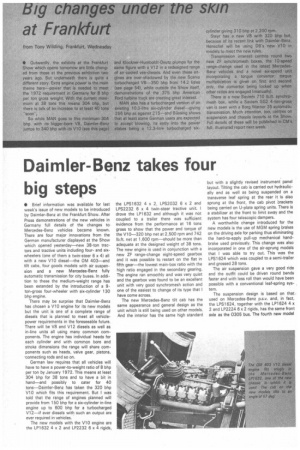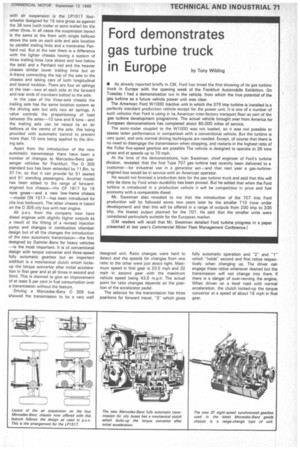Daimler-Benz takes four big steps
Page 72

Page 73

If you've noticed an error in this article please click here to report it so we can fix it.
• Brief information was available for last week's issue of new models to be introduced by Daimler-Benz at the Frankfurt Show. After Press demonstrations of the new vehicles in Germany full details of the changes to Mercedes-Benz vehicles became known. There are four major innovations from the German manufacturer displayed at the Show which opened yesterday—new 38-ton tractors and tractive units including fourand sixwheelers (one of them a twin-steer 6 x 4) all with a new V10 diesel—the OM 403—and tilt cabs, four goods models with air suspension and a new Mercedes-Benz fully automatic transmission for city buses. In addition to these the medium-weight range has been extended by the introduction of a 9ton-gross four-wheeler with six-cylinder 130 bhp engine.
There may be surprise that Daimler-Benz has chosen a V10 engine for its new models but the unit is one of a complete range of diesels that is planned to meet all vehiclepower requirements in the foreseeable future. There will be V8 and V12 diesels as well as in-line units all using many common components. The engine has individual heads for each cylinder and with common bore and stroke dimensions the range will share components such as heads, valve gear, pistons, -connecting rods and so on.
German law requires that all vehicles will have to have a power-to-weight ratio of 8 bhp per ton by January 1972. This means at least 304 bhp for 38 tons and to have a bit in hand—and possibly to cater for 40 tons—Daimler-Benz has taken the 320 bhp V10 which fits this requirement. But I was told that the range of engines planned will provide from 150 bhp for a six-cylinder in-line engine up to 600 bhp for a turbocharged V12—if ever diesels with such an output are ever required in vehicles.
The new models with the V10 engine are the LP1632 4 x 2 and LP2232 6 x 4 rigids, the LPS1632 4 x 2, LPS2032 6 x 2 and LP52232 6 x 4 twin-steer tractive unit. I drove the LP1632 and although it was not coupled to a trailer there was sufficient evidence from the performance at 16 tons gross to show that the power and torque of the V10-320 bhp net at 2.500 rpm and 742 lb.ft. net at 1.600 rpm—should be more than adequate at the designed weight of 38 tons. The new engine is used in conjunction with a new ZF range-change eight-speed gearbox and it was possible to restart on the flat in fifth gear—the lowest main-box ratio with the high ratio engaged in the secondary gearing. The engine ran smoothly and was very quiet and the gearbox was found to be an excellent unit with very good synchromesh action and one of the easiest to change of its type that I have come across.
The new Mercedes-Benz tilt cab has the same appearance and general design as the unit which is still being used on other models. And the interior has the same high standard but with a slightly revised instrument panel layout. Tilting the cab is carried out hydraulically and as well as being suspended on a transverse leaf spring at the rear it is also sprung at the front, the cab pivot brackets being carried on U-plate spring units. There is a stabilizer at the front to limit sway and the system has four telescopic dampers.
A worthwhile change introduced for the new models is the use of MGM spring brakes on the driving axle for parking thus eliminating the hard-to-apply pull-up mechanical handbrake used previously. This change was also incorporated in one of the air-sprung models that I was able to try out. This was the LPS1624 which was coupled to a semi-trailer and grossed 28 tons.
The air suspension gave a very good ride and the outfit could be driven round bends faster and with less roll than would have been possible with a conventional leaf-spring system.
The suspension design is based on that used on Mercedes-Benz p.s.v. and, in fact, the LPS1624, together with the LP1624 4 x 2 and LP2224 6 x 2 rigids, has the same front axle as the 0305 bus. The fourth new model with air suspension is the LP1517 fourwheeler designed for 15 tons gross as against the 38 tons (with trailer or semi-trailer) for the other three. In all cases the suspension layout is the same at the front with single bellows above the axle on each side and axle location by parallel trailing links and a transverse Panhard rod. But at the rear there is a difference with the lighter chassis having a system of three trailing links (one above and two below the axle) and a Panhard rod and the heavier chassis sirhilar lower trailing links but an A-frame connecting the top of the axle to the chassis and taking care of both longitudinal and lateral location. There are four air sPrings at the rear -two at each side at the forward and rear ends of members bolted to the axle.
In the case of the three-axle chassis the trailing axle has the same location system as the driving axle but only two air springs. A valve controls the proportioning of load between the axles-10 tons and 6 tons—and the trailing axle can be raised by an air bellows at the centre of the axle, this being provided with automatic control to prevent more than 10 tons being applied to the driving axle.
Apart from the introduction of the new automatic transmission there have been a number of changes to Mercedes-Benz passenger vehicles for Frankfurt. The 0 305 standard bus has been extended by 11 Bin, to 37.1 in. so that it can provide for 51 seated and 51 standing passengers. Another model has been added to the range of forwardengined bus chassis—the OF 1617 for 16 tons gross—and a new low-frame chassis —model ON 1517—has been introduced for city-bus bodywork. The latter chassis is based on the 0 305 city bus with rear engine.
All p.s.v. from the company now have diesel engines with slightly higher outputs as a result of the fitting of a revised injection pump and changes in combustion chamber design but of all the changes the introduction of the new automatic transmission—the first designed by Daimler-Benz for heavy vehicles —is the most important. It is of conventional design with torque converter and three-speed fully automatic gearbox but an important addition is a mechanical clutch which locksup the torque convertor after initial acceleration in first gear and at all times in second and third. This is claimed to give an improvement of at least 5 per cent in fuel consumption over a transmission without the feature.
Driving a Mercedes-Benz 0 305 bus showed the transmission to be a very well designed unit. Ratio changes were hard to detect and the speeds for changes from one ratio to the other were just about right. Maximum speed in first gear is 20.5 mph and 32 mph in second gear with the maximum vehicle speed being 43.5 m.p.h. The actual point for ratio changes depends on the position of the accelerator pedal.
The selector for the transmission has three positions for forward travel, "3" which gives fully automatic operation and "2" and "
which "holdssecond and first ratios respectively when changing up. The driver can engage these ratios whenever desired but the transmission will not change into them if there is a danger of over-revving the engine. When driven on a level road with normal acceleration, the clutch locked-up the torque convertor at a speed of about 15 mph in first gear.




































































































































































































